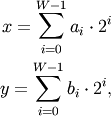numpy.bitwise_and¶
- numpy.bitwise_and(x1, x2[, out])¶
Compute bit-wise AND of two arrays, element-wise.
When calculating the bit-wise AND between two elements, x and y, each element is first converted to its binary representation (which works just like the decimal system, only now we’re using 2 instead of 10):

where W is the bit-width of the type (i.e., 8 for a byte or uint8), and each
 and
and  is either 0 or 1. For example, 13
is represented as 00001101, which translates to
is either 0 or 1. For example, 13
is represented as 00001101, which translates to
 .
.The bit-wise operator is the result of

where
 is the AND operator, which yields one whenever
both
is the AND operator, which yields one whenever
both  and
and  are 1.
are 1.Parameters: x1, x2 : array_like
Only integer types are handled (including booleans).
Returns: out : array_like
Result.
See also
bitwise_or, bitwise_xor, logical_and
- binary_repr
- Return the binary representation of the input number as a string.
Examples
We’ve seen that 13 is represented by 00001101. Similary, 17 is represented by 00010001. The bit-wise AND of 13 and 17 is therefore 000000001, or 1:
>>> np.bitwise_and(13, 17) 1
>>> np.bitwise_and(14, 13) 12 >>> np.binary_repr(12) '1100' >>> np.bitwise_and([14,3], 13) array([12, 1])
>>> np.bitwise_and([11,7], [4,25]) array([0, 1]) >>> np.bitwise_and(np.array([2,5,255]), np.array([3,14,16])) array([ 2, 4, 16]) >>> np.bitwise_and([True, True], [False, True]) array([False, True], dtype=bool)
